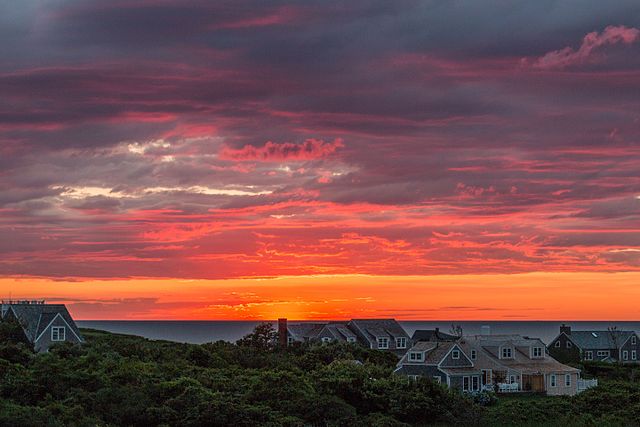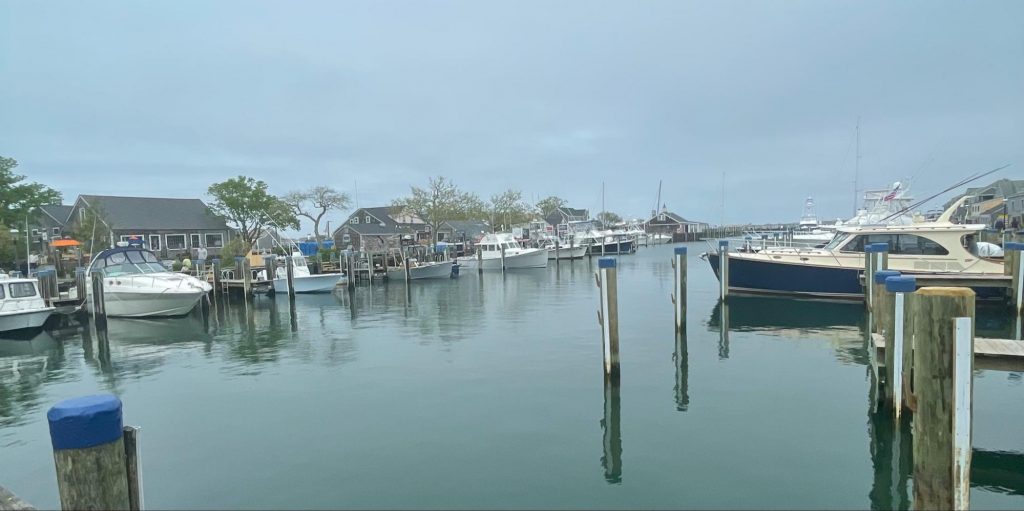
Wikimedia Commons/Tim Sackton
My grandmother recently took me on a trip to the east coast, with our goal to tour historical sites and visit as many notable places as we could. We spent little time in each location, darting from one place to the next without fully being able to take in everything. While in Massachusetts, we decided to take a day trip to Nantucket Island, a place I had only seen on the juice bottles at Chipotle. Expecting to see long beaches and picturesque lighthouses, I was surprised to find an upper-class haven: a party island for the young and wealthy where money is thrown around with ease, and where a long history of greed and elitism is veiled by an Eden-like appearance.
Nantucket is only accessible by ferry (that is, unless you have a yacht of your own, which is the case for many islanders), an hour-long ride. The ferry departs from Hyannis, a small, touristy port town made famous as the location of former President John F. Kennedy’s summer home. After getting our tickets and waiting in line, we managed to find seats in the center section of the ship.
It didn’t take long for me to feel out of place. Our seats were close to the onboard cafe, home to a small bar proudly selling solo-cup Bloody Marys at 9 a.m. The line ran the length of the cabin, filled with groups of young people chatting loudly, evidently anticipating their time on the island. “I’m trying to be drunk before I get off the boat,” a man in a Vineyard Vines polo and a sweater tied around his neck yelled to his friend further up the line.
I was surprised by the apparent ease these people felt being surrounded by luxury. Most women had Louis Vuitton purses and bags, Prada or Gucci sunglasses (even on an eerily overcast day). The men wore their preppy, East Coast attire like an extension of themselves, spoke to women around them with an air of confidence that felt more predatory than charming and sported backpacks and merch from Colby College (Maine), Harvard University (Ma.) and Tufts University (Ma.).
On the ferry, I spent most of my time looking out the window and trying to isolate conversations to identify themes in their discussions. When the cacophony of young white elites became too much, I began to imagine what the island would have been like centuries before. In 1602, Englishmen arrived on Nantucket and were immediately impressed by its expansive shoreline and potential for development. It had been inhabited by the Wampanoag for many years before, Native Americans who lived in parts of what is now Rhode Island, Massachusetts, Martha’s Vineyard and Nantucket.
There were between about 1,500 Wampanoag living on the island when the English arrived, but it didn’t take long before that number greatly diminished, with thousands dying from disease spread by colonizers. Today, only 500 Wampanoag live on Martha’s Vineyard and even fewer reside on Nantucket. The only attempt to recognize Wampanoag history is with street names and place names like “Sconset” and “Quidnet,” names which are put on t-shirts and hoodies, capitalizing off of what can loosely be called a memorial to their history and culture. In doing so white Nantucketers cover the true history, reframe the narrative of ownership as if the island was theirs from the beginning and romanticize their ancestor’s history of colonization.
Years later, Nantucket began to develop its economy. In the 1700s, Nantucket had emerged as a modest whaling port which supported economic development on the island. Many of the buildings from this period are still standing. However, instead of being homes for seamen and their families, they serve as boutique locations for Ralph Lauren, high-end jewelers and popular sandwich shops selling $9 PB&Js.
From the moment we stepped off of the ferry, we were immediately plunged into the commotion of islandgoers hustling to their taxis and Ubers, the men paid to carry their bags trailing not far behind. We passed an outdoor bar that could barely contain the number of people inside of it, young men stumbling out in their linen pants and well-kept Sperry’s. There was an evident divide between people visiting the island as tourists and those there to visit family or party with friends: the latter carried themselves with confidence, not stopping to take pictures or read plaques, the charm of Nantucket’s sights dulled after countless visits. Glances from islandgoers felt cold. The way they carried themselves was steeped with an air of ownership, of their rightful claim to the land they walked on.
On a bus tour of the island, I noticed that there were more people of color in the station than anywhere else we had been on the island that morning — a testament to the island’s predominantly white and exclusive nature, as the island is only 16% people of color, while many more visit for tours.
We stopped frequently to admire old cemeteries, homes and windmills, and I began to realize that much of the tour focused on the wealth and exclusivity of the island. Our tour guide pointed out how expensive the hotels were, sometimes over $1,000 a night; how long it took to get reservations at restaurants on the island – many are booked a year in advance; and the many well-known wealthy families and individuals who have inhabited the island. As the tour guide told us that the median home value is over $2 million, passengers paused to take pictures of Bill Belichek’s mansion, and crane their necks to get a glimpse of the famous hedges in Sconset. Tourists do what Nantuckers expect them to: they romanticize the island, see it as a paradise of ordered luxury and marvel at the exclusivity of the land they stepped foot on.
As the tour ended, we walked to a nearby sandwich shop. It felt like a fine dining restaurant crammed into a small space: $12 ham and cheese sandwiches, an upscale interior with leather seats and a high-end espresso bar. I noticed that nearly all of the workers were speaking in languages other than English. The line between server and patron is drawn starkly: one is international, working-class, and seeing the island from the outside, while the other feels connected to the land, owning and controlling the island rather than gazing upon it.
It wasn’t always the case that Nantucket employed international workers. In the 1980s and 90s, Ivy league students worked summers on the island, waiting tables for extra cash, paying for housing with their parents’ money. In recent years, the increased expectation for more “meaningful” summer work, the rising cost of housing on the island and the greater influx of tourists caused wealthy students to stop coming to Nantucket. Instead, employers hired seasonal workers from around the world — workers who are not accepted into island social life like college students are.
At first, Nantucket businesses recruited British workers with J1 visas, a student exchange program in which countries would “swap” young laborers for the summer. As students reported back about their time on the island, however — exposing the poor housing conditions and long work hours — colleges began advising their students to find work in different places.
Businesses turned to older workers, who are able to live on the island for longer periods of time. Using the H2-B visa program, which brings foreign citizens to the U.S. for temporary work, Nantucket began to employ hundreds of Caribbean and South American workers. The line between the island’s elite and the working class is evident. Though they can often make better money than at home, Caribbean workers are placed in a system in which they are instantly marked as inferior, deemed subservient by the color of their skin alone — and expected to serve with a smile on their face.
As one Nantucket lawyer said in 2003, “Jamaicans have now replaced in good part the reliable low-level labor that all businesses needed. The American labor force wasn’t cutting it. We needed the work ethic of doing it, not complaining about it and wanting more afterward.” Perspectives like these reinforce stereotypes that international workers will do any kind of labor without complaint, an incredibly harmful, dehumanizing belief which serves to distract from their exploitation.
Although housing conditions improved marginally since the early 2000s, workers were still paying incredibly high prices for small living space — sometimes over $2,100 a month for a one bedroom apartment. Several workers have been paying to sleep on basement floors and in old shipping containers during the summer. In an attempt to remedy this problem, the Nantucket Land Bank proposed a public housing development for seasonal workers, a proposition which was instantly combated by several of the island’s wealthy. The mere prospect of affordable housing for workers scared some Nantucketers into action, fearing a drop in their home’s value more significant than the wellbeing of their restaurant servers and shopkeepers.
David Long, the CEO of Liberty Mutual and owner of a Nantucket estate, recruited Boston lawyers to combat the development, lobbying environmental officials that such a project was “at odds with the interests of conservation.” After a drawn out legal battle, plans for the development are still unclear, and workers continue to suffer from limited housing.
Thus, Nantucket exists in a state of cognitive dissonance: the desire for willing, international workers and the unwillingness to support them. There is fierce competition for H2-B visas, with Jamaicans and other Caribbean islanders seeking the extra cash to support their families, often leaving their children at home as they work for up to nine months at a time. As a result, Nantucket businesses do not feel the need to spend extra money to support their workers, as there are others waiting in line for a chance to work on the island.
There is another narrative on Nantucket that is often overlooked: Black Americans have inhabited the island for centuries, calling the land home well before the CEOs and preppies claimed it as their own. Many of them arrived after escaping enslavement during the late 1700s, with some white Nantucket families providing shelter from the bounty hunters sent after them. Black men served as sailors on whaling ships, owned land and started businesses and organized abolition movements in the African Meeting House. The tour we went on made no mention to their history or legacy, and many Nantucketers are not aware of Black history on the island. While Martha’s Vineyard serves as a summer oasis for thousands of Black families every year, Nantucket — both actively and passively — remains a sanctuary for white elites.

Image courtesy of Carson Kindred
As we walked back to the ferry, the smell of the salty sea air got stronger, and a low fog rolled in. Boats in the marina were perfectly still, the waves diminished to a small ripple. We passed gift shops selling all types of Nantucket-themed merchandise. One sign, parodying a dictionary definition, read: “Nantucket [noun], a place or feeling of belonging, a gathering place where you will always be surrounded with love.”
This was not true for the thousands of Wampanoag who were driven out of their land. This is not true of the hundreds of yearly workers who serve their patrons with grace, despite never being truly welcomed to the island. Nantucket sells an image: one of pristine lawns and long beaches, quaint island estates and old cobblestone streets. It expects you to gawk at its beauty, be awed by its history and aspire to be a part of it, to stake your part of paradise, while knowing full well that most of us will never belong.
Carson Kindred (25C) is from Minneapolis, Minnesota.
Carson Kindred (he/him) (23Ox, 25C) is studying political science and philosophy and serves on the Editorial Board. He is a consultant for the Emory Writing Center and a research assistant for The Center for Working Class Politics. He recently worked for the Philadelphia District Attorney’s Office as a researcher supporting a community-led violence prevention program. In his free time, Carson loves to read, make music, and root for Minnesota sports teams no matter how bad they’re losing.





